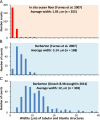Paleoarchean trace fossils in altered volcanic glass
- PMID: 26038543
- PMCID: PMC4460447
- DOI: 10.1073/pnas.1421052112
Paleoarchean trace fossils in altered volcanic glass
Abstract
Microbial corrosion textures in volcanic glass from Cenozoic seafloor basalts and the corresponding titanite replacement microtextures in metamorphosed Paleoarchean pillow lavas have been interpreted as evidence for a deep biosphere dating back in time through the earliest periods of preserved life on earth. This interpretation has been recently challenged for Paleoarchean titanite replacement textures based on textural and geochronological data from pillow lavas in the Hooggenoeg Complex of the Barberton Greenstone Belt in South Africa. We use this controversy to explore the strengths and weaknesses of arguments made in support or rejection of the biogenicity interpretation of bioalteration trace fossils in Cenozoic basalt glasses and their putative equivalents in Paleoarchean greenstones. Our analysis suggests that biogenicity cannot be taken for granted for all titanite-based textures in metamorphosed basalt glass, but a cautious and critical evaluation of evidence suggests that biogenicity remains the most likely interpretation for previously described titanite microtextures in Paleoarchean pillow lavas.
Keywords: Paleoarchean; astrobiology; biogeosciences; early life; ichnofossil.
Conflict of interest statement
The authors declare no conflict of interest.
Figures


Comment in
-
Questioning the biogenicity of titanite mineral trace fossils in Archean pillow lavas.Proc Natl Acad Sci U S A. 2015 Jun 16;112(24):E3090-1. doi: 10.1073/pnas.1506995112. Epub 2015 May 18. Proc Natl Acad Sci U S A. 2015. PMID: 26082550 Free PMC article. No abstract available.
-
Reply to Grosch and McLoughlin: Glass bioalteration trace fossils can be preserved by titanite in Paleoarchean greenstones.Proc Natl Acad Sci U S A. 2015 Jun 16;112(24):E3092. doi: 10.1073/pnas.1507722112. Epub 2015 May 18. Proc Natl Acad Sci U S A. 2015. PMID: 26082551 Free PMC article. No abstract available.
References
-
- Furnes H, Staudigel H. Biological mediation in ocean crust alteration: How deep is the deep biosphere? Earth Planet Sci Lett. 1999;166(3-4):97–103.
-
- Staudigel H, et al. 3.5 billion years of glass bioalteration: Volcanic rocks as a basis for microbial life? Earth Sci Rev. 2008;89:156–176.
-
- Furnes H, Banerjee NR, Muehlenbachs K, Staudigel H, de Wit M. Early life recorded in Archean pillow lavas. Science. 2004;304(5670):578–581. - PubMed
-
- Banerjee NR, Furnes H, Muehlenbachs K, Staudigel H, de Wit M. Preservation of ∼3.4–3.5 Ga microbial biomarkers in pillow lavas and hyaloclastites from the Barberton Greenstone Belt, South Arica. Earth Planet Sci Lett. 2006;241(3-4):707–722.
-
- Banerjee NR, et al. Direct dating of Archean microbial ichnofossils. Geology. 2007;35(6):487–490.
Publication types
MeSH terms
LinkOut - more resources
Full Text Sources
Other Literature Sources
Medical

